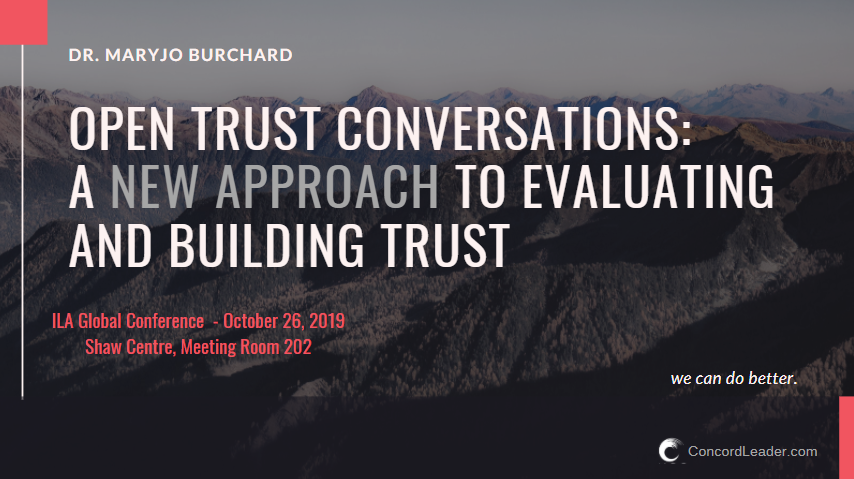“You may be deceived if you trust too much, but you will live in torment unless you trust enough.” –Frank Crane
Few things take more courage than trust. Our unique organizational trust consulting approach uses ASC-DOC Trust Model, which provides a new language to help people break trust into specific areas, making it possible to both reinforce trust that is present and build trust where it is lacking, in real time.
Imagine how much things could change if everyone had a language to describe where trust is strong and where trust needs to grow.
This approach assumes that healthy trust engagement must be reciprocal – I choose to trust you, you choose to trust me. Each person is both trustor and trustee. Our capacity to trust ourselves also plays a crucial role in our perceptions and growth in trust.
A shared language makes room for a trust-building process that
(1) Identifies where trust exits between people
(2) Finds exactly where trust needs to grow, and
(3) Facilitates solution-based, open conversations to build and reinforce trust according to each person’s expressed needs
Build trust incrementally.


6 trust dimensions
The ASC – DOC Trust Model
When trust is no longer all-or-nothing, the venture to build or rebuild it is worth the risk.
We make room for real solutions and the hope of future growth.
AUTHENTICITY: You are convinced that the trustee is genuine; you believe you see and hear who they really are. You believe words and actions are real, sincere, honest.
SAFETY: You feel safe around the trustee. They behave in ways that help you feel more confident and less threatened. You sense they will be careful with you.
CONSISTENCY: You can base your decisions on the trustee’s predictable words and actions.
DEPENDABILITY: You sense the trustee will follow through with any and every commitment.
OWNERSHIP: You sense that the trustee will take personal responsibility for what you entrust to them. You sense that they bear the weight of the outcome.
COMPETENCE: You sense the trustee has the skills, knowledge, experience, and discernment to do what is expected in the situation.
Confronting impostor syndrome
Overcoming Imposter Syndrome begins with self-trust – closing the trust gaps in your own head.
“Imposter syndrome” – the sometimes overwhelming sense that you are not really qualified to be doing what you are doing, and if only the others in the room knew who you really are, you would be exposed and expelled as an imposter. Imposter syndrome may be triggered when you find yourself in an environment where you are highly impressed with the expertise and accomplishments of others, while feeling that your own expertise and accomplishments (which may be parallel on paper) are somehow a sham – and if anyone ever really saw what was going on in your head, you would be discovered as the fraud you feel you are.
But in the truest sense, imposter syndrome is simply questioning your ability to trust yourself. To overcome this, the trust conversation in your own head needs to be multidimensional, specific, and measured. When you are blindsided by overwhelming feelings of imposter syndrome, here’s how you can use the ASC-DOC trust model to confront the “You’re a fraud!” voice in your own head.
(1) Remember that everyone who dares to do outrageous, risky, important things will eventually need to confront imposter syndrome. People who dare to go into the arena will only survive when they master their self-talk. Learn to listen to the voice that is infused with compassion rather than fear.
(2) Do a full-range trust scan of your self-trust. Where is self-trust strong? For example . . .
– When do you trust your own authenticity? How far back do you need to go to find a memory when you knew you were engaging with others with an open heart and no hidden agenda? What did you say and do that made you confident in your own authenticity?
– When do you trust your ability to make yourself and others feel safe? How far back do you need to go to remember when you were good at making someone else feel safe and secure? What dis you say and do to feel confident in your ability to make them feel safe with you?
– What areas do you see consistency in your life? Are these areas that you want to be known for consistency in?
– When was the last time you felt confident in your ability to keep your promises and commitments? How did you reinforce this dependability in your actions and words?
– How frequently have you seen yourself taking ownership of weighty responsibilities, staying committed until you carry the responsibility to the end? How confident are you in your ability to do this in your current situation(s)?
– When have you observed your own competence in action…socially? professionally? technically? in other areas? Where are the limitations to your observed competence?
(3) Reinforce the areas of self-trust you already possess. Write them down and/or say them out loud (even if in a whisper) Name the areas you have solid proof that you have been able to trust your legitimate ability to be worthy of your own trust. This provides a baseline of confidence – you know in these areas you are REALLY and LEGITIMATELY trustworthy, even if you are tempted to feel vulnerable and illegitimate in a given situation.
(4) Name the dimensions of trust in which you are struggling with self-trust. Can you identify when this struggle began (e.g., are you in a new environment? did you experience a trauma? etc.) Think of a time you trusted in this area. What did the person you trusted say and do to help you trust them in this way? How are your actions and words different from those of the person you trusted in the memory?
(5) Intentionally act and speak in ways that build self-trust where it is lacking. Remember what “trustworthy” looked and felt like when you gave trust to others, and do the same trustworthy things with yourself.
(6) Give yourself room to grow. Change the way you talk to yourself – remind yourself where trust exists, and accept your intentional actions toward yourself to be “trustworthy.” Tell yourself you believe your own intent to be caring, as if you were receiving care from someone you love.
Trust resources
the concord leader blog
Thoughts to feed your curiousity about things that matter most.
What are you waiting for?





